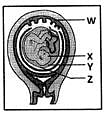Important Questions: Reproduction in Animals - Class 8 MCQ
15 Questions MCQ Test Science Class 8 - Important Questions: Reproduction in Animals
Which of the following statements is true about asexual reproduction?
B Which of the following is NOT an example of asexual reproduction?
| 1 Crore+ students have signed up on EduRev. Have you? Download the App |
Which of the following is/are paired structure in human reproductive system?
Which of the following statements about the human female egg cell is incorrect?
Identify W, X, Y and Z in the given figure.

Which part within the uterus prevents the mixing of the blood of the foetus with that of the mother?
Which of the following sequences is in the correct order?
Which of the following comparisons are true of sexual and asexual reproduction?

How are Paramecium and Amoeba are similar?
In which of the following parts of the female reproductive system does fertilization occur?
The animals that produce new young ones are called
Which of the following shows external fertilisation?
Read the given information and identify P, Q and R.

The substances that are transported through umbilical cord
In Hydra, the mode of reproduction is
|
91 videos|273 docs|44 tests
|


















